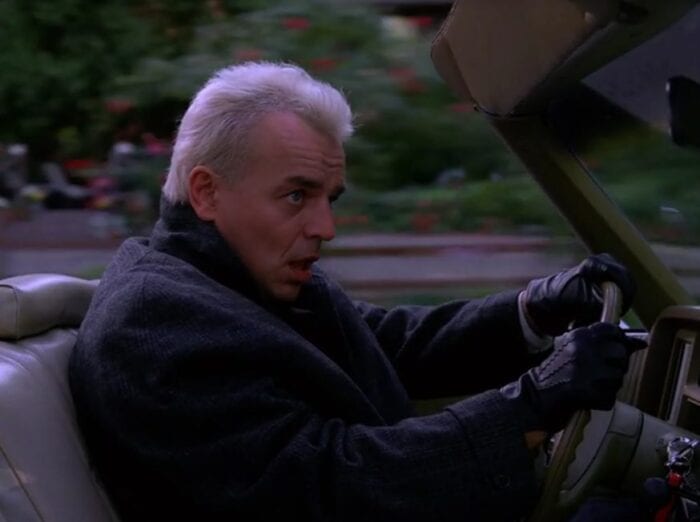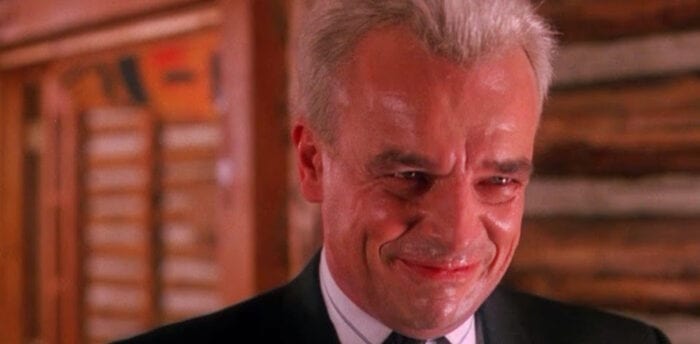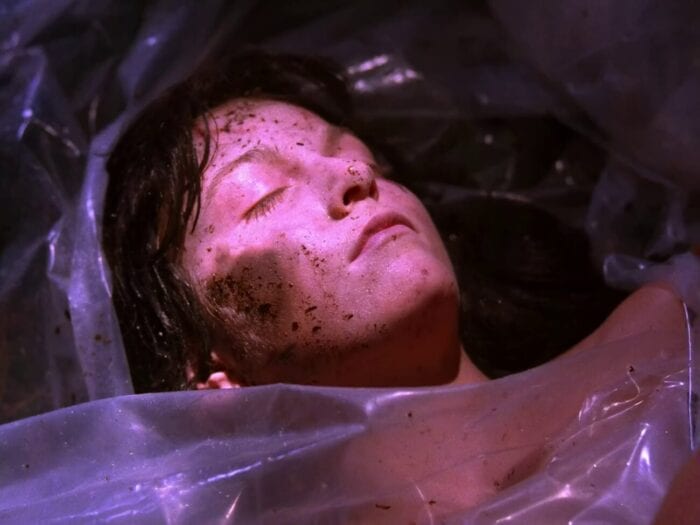Twin Peaks Episode 15 opens with the aftermath of Maddy’s murder—the Palmer house now in the cold light of day with an echo of her scream cutting across the opening frames. Which can now only make us think of another scream in relation to this house—that of Carrie Page at the end of Part 18 of The Return as she comes to herself and the memories of Laura Palmer, with our dear friend Dale stumbling in confusion in the street, wondering: “What year is this?”
We see signs of that confusion through Episode 15, if not in as striking or direct a way, as Dale somewhat bumbles his way through the investigation into Laura’s death in its late stages, failing to suspect Leland even as he behaves in a highly suspicious manner, and trying to put it to Ben Horne in an interrogation that can only seem off base since we know—and knew even when Episode 15 originally aired—that it isn’t Ben but Leland who killed Laura Palmer. (And aren’t there shades of Mr. C in this scene, as Cooper “pretends” to relate to Ben about young girls, and can we help but think of that again when Audrey visits his hotel room at the end of the episode?)

Episode 15 continues the shots of BOB looking back when Leland looks in the mirror, and though these images have always struck me as verging on the cheesy, there has also always been a kind of uncanniness to them, with Frank Silva’s maniacally grinning portrayal of BOB infusing even what should be ridiculous with an underlying sense of dread and terror. Perhaps it is as Slavoj Žižek might suggest—the ridiculous sublime.
Certainly, there is something sublime in Ray Wise’s portrayal of Leland Palmer, and Episode 15 is a touchstone for this aspect of the character that sticks in one’s memory, dancing about the Great Northern with a golf club or erratically driving down the road whistling “Surrey with the Fringe on Top” (note the song references two white horses).

Dale whistles some notes of that very same tune in that scene, even though he is in an entirely different vehicle. Of course, he couldn’t be hearing the notes passing from Leland’s lips here, which has elsewhere led me to speculate about a deep connection between Dale and BOB cutting across the normal dimensions of space and time.
All sorts of elements in Episode 15 resonate with bits of Twin Peaks: The Return, as when Cooper, towards the end of the episode, tells Diane through his tape recorder that it is a night with no stars. Cue Rebekah Del Rio on stage at the Roadhouse. Or when Jerry arrives to visit Ben in his (notably dirty) prison cell early on in Episode 15, he says (after mentioning changes in timezone and his crossing of the international dateline) that he doesn’t even know where he is. And surely his foot has abandoned him.

We also get in this scene a flashback to when Ben and Jerry were children, as Louise Dombrowski dances with a flashlight for the young versions of the men as they repose on their bunk beds. It is a drawn-out scene, but who gives a f*cking sh*t how long a scene is. And it relates to nothing but the creation of mood and an evoking of nostalgia through this fragment that calls out for the kind of story where it would fit coherently. But instead, Jerry wonders to Ben what they have become, as their identities are so far from their childhood selves by the time they reach this moment in Episode 15 that the memory seems like a dream dreamt almost by someone else.
Louise dances with a flashlight, while Leland dances with a golf club. The dancing communicates a feeling more than any determinate meaning, much as it does when Audrey dances, whether at the beginning of Twin Peaks or at the end of her story. Is it the story of the little girl who lived down the lane? Is it? Or is that girl wrapped in plastic in Leland’s golf bag, stuffed into the trunk of his car. And why does he want to show those clubs to Dale?
It’s as though BOB becomes reckless throughout the hour of Episode 15, or perhaps I should say Leland does. I have often wondered, with those aforementioned shots of Leland looking into the mirror to see BOB grinning back at him, whether Leland always knew about BOB or was only discovering him here. In other words, was this merely a reveal to the audience of Twin Peaks—what may be the obvious interpretation—or is it perhaps rather a showing of the reveal of Leland (BOB) to himself?
There is no reason to think that BOB was always perspicuous to Leland, if you think about it. After all, what is BOB if not a certain kind of personification of the deepest, darkest impulses of the unconscious—a supernatural being, perhaps? Maybe so, but even then it would make sense to think of BOB as being hidden within Leland and only made manifest to him in those days leading up to Episode 15. Here, now, things are fully clear. The smiling man looks back at Leland from behind the glass and the same sort of maniacal grin takes over Leland’s own face at the Great Northern after Coop and Truman tell him they have arrested Ben Horne. It is a moment that lodges in your psyche, as Leland cries/laughs/smiles upwards—a congealing of various human elements into an expression that is hard to describe with words. Everybody run.

And besides the unsolicited offer to show Cooper his golf clubs (in the bag that contains Maddy’s corpse), we have Leland offering to Dale and Truman that he overheard Ben angry on the phone the night Laura died. He says he heard something about a “dairy” and Cooper jumps to “diary,” but that has to be exactly what Leland intended to have happen. There is nothing more effective than getting someone to think that they came up with the idea you want them to land on themselves.
And yet, why even do this? That dead girl he’s taking a drive with is going to turn up at the end of Episode 15, wrapped in plastic, while Ben Horne sits in prison. I do not think it makes sense to conceive of this as a mistake any more than the erratic driving that causes him to be pulled over before he makes the offer about the golf clubs. It may be hubris, but a step more compelling to me is the thought that BOB is an agent of chaos, looking for fun. After all, it is Leland’s garmonbozia that he delivers at the end of Fire Walk with Me.

Speaking of food, Episode 15 sees Norma’s mother Vivian arrive in Twin Peaks with her new husband Ernie. It won’t be until later that we learn that Vivian is the food critic, MT Wentz, whom the Jennings have been expecting, but we already get a hint of it as she butts in to taste Toad’s mashed potatoes, wondering aloud to Norma if they might be made from dehydrated flakes. We can see how deeply Norma is hurt—and offended—by the suggestion, but this is only deepened if we think now about the scenes between her and Walter in The Return. Everything is at stake in the quality of food at the Double R. And in case we doubted the centrality of this question to Twin Peaks, we have the Log Lady intro to Episode 15 to remind us:
Food is interesting; For instance, why do we need to eat? Why are we never satisfied with just the right amount of food to maintain good health and proper energy? We always seem to want more and more. When eating too much the proper balance is disturbed, and ill health follows. Of course, eating too little food throws the balance off in the opposite direction, and there is the ill health coming at us again.
Balance is the key. Balance is the key to many things. Do we understand balance? The word ‘balance’ has seven letters. Seven is difficult to balance, but not impossible—we are able to divide. There are, of course, the pros and cons of division.
And food is again central to The Return, from Chantal’s Cheetos to the salvation delivered by cherry pie. The Cheeto is corn fried in oil, bringing together those pervasive symbols in the world of Twin Peaks. Like the apotheosis of creamed corn filling cans at the convenience store, the processed corn in a bag signifies the garmonbozia of our (post)modern, post-nuclear age. Mr. C likes the Flamin’ Hot variety—fire walk with me.
The Log Lady speaks of balance, but Episode 15 epitomizes the lack of it, from Leland’s descent into the off-kilter shenanigans of BOB to the interjections of Lucy’s sister Gwen about unleashing another sperm gun onto the world by giving birth to a son. And the balance (or lack thereof) between competing aspects of self is on display as Ernie Niles swears to Hank that he’s trying to live an honest life, no longer engaged in gambling, while we saw evidence of a wager written on his newspaper at the Double R earlier in the hour. And it is on display with Pete, swinging from sweet musings and concerns about Josie as he talks with Sheriff Truman to the most maniacal version of the character we see as he presents Ben with the recording of Catherine’s demands. He even kisses the tape recorder.
This isn’t the only tape recorder in Episode 15. There is also, of course, Dale’s device, as he talks to Diane in his room at the Great Northern. And further, there is Bobby, playing one tape recorder to another as he prepares to blackmail Ben Horne himself. It is a fascinating machine, when you think about it—a voice and nothing more, inscribed onto a flat surface, spun around a spindle, detached from its body of flesh and blood, and recreated through a varying electromagnetic field.
We don’t know how Diane receives Dale’s tapes in the original run of Twin Peaks, or at what speed, but it is no surprise that we find the tape recorder replaced by the cellphone in The Return, or that Mr. C aspires to collect many of them. Now it is this device—equally magical if not more so—that carries the spirit across the electricity that hums silently through the air around us.

It is a night with no stars as Episode 15 ends, and Dale learns that it has happened again. She’s dead, wrapped in plastic, this cousin—but doesn’t she look almost exactly like Laura Palmer?

